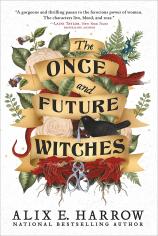The Once and Future Witches
Review
The Once and Future Witches
Hugo Award-winning author Alix E. Harrow returns with her second novel, THE ONCE AND FUTURE WITCHES, a spellbinding and empowering story set in an alternate America where magic exists.
In 1893, there is no such thing as witches. Magic used to run wild, helping mothers care for their families and cure illnesses, but after the burnings and the demolition of Old Salem, magic and the lore of witchcraft have been diminished to close to nothing. In every household, though, mothers quietly pass down tidy little charms to their daughters, using nursery rhymes and fairy tale refrains to mend socks, keep linens crisp and prevent water from boiling over. The Eastwood sisters --- James Juniper, Agnes Amaranth and Beatrice Belladonna --- know a few of these tricks themselves, passed down to them by their grandmother, Mags. But they have not seen each other in seven years, having been separated by their father’s cruelty, vicious rumors and whispers of betrayal.
When the sisters reunite in New Salem, the suffragette movement is just gaining momentum, with a group of well-to-do women trying to reclaim some power in their lives, marriages and communities (assuming that power is limited to white women, of course). Despite being apart for a long time, they end up in the same town square just at the moment that the universe rips open, revealing a magical tower hidden in a tangled wood: the Lost Way of Avalon, the legendary final home of the Maiden, the Mother and the Crone, the world’s best-known witches. The tower disappears as quickly as it appeared, but the sisters know that magic has not left New Salem, and they form an uncomfortable union --- filled with tension, hurt and secrecy --- to try to bring power back to women, through both the vote and witchcraft.
"...the perfect brew of magic and power.... Harrow provides readers with an intoxicating mix of fantasy and reality that will speak to both the powerless and the empowered, igniting a new fury within all who read it."
Alternating perspectives among the three sisters, Harrow pens a story of hurt and betrayal, but also one of all-encompassing sisterly love. They couldn’t be more different from one another, but their shared history and hopes for the future bring them together at a comfortable but emotionally charged pace. Belladonna is the eldest of the three, a rule-abiding librarian who finds magic in words and records, but who also struggles with her secret attraction to a local Black reporter, Cleopatra Quinn. Amaranth, the middle sister, is perhaps the most steadfast of the three, thoughtful and pragmatic --- and pregnant, out of wedlock.
If there is a main character here, it is Juniper, the youngest and wildest sister who is most emphatic in her beliefs. A life of pain and torment has simmered into a boiling rage within her, and though she is young and inexperienced, she will stop at nothing to put that rage to use. Starting from her very first encounter with the suffragettes, it is Juniper who believes with all her willpower and might that women should be inquisitive, angry and bold, and that securing the vote and regaining witchcraft is the best way to do it.
But there is another force battling for control of New Salem. At the same time that the Eastwood sisters are forming a secret coven, the Sisters of Avalon, far-right religious groups are walking the streets, and local politicians are using witches as scapegoats for disease, poverty and anything else they can think of (sound familiar?). Leading the charge against the witches is Gideon Hall, a sniveling worm of a man who controls not only New Salem’s rumor mill but, strangely, its shadows. As the Eastwoods and their coven form a new collection of spells compiled from the passed-down whispers and songs of their fellow witches and their mothers, Gideon does everything he can to fuel panic in New Salem, drawing the history of Old Salem, with all its trauma and tragedy, painfully close to the present and forcing the sisters to take dramatic action before witchcraft --- and their newfound, reclaimed bond --- is lost forever.
At over 500 pages, THE ONCE AND FUTURE WITCHES is no brief foray into Salem and witchcraft, yet I read the entire book in one breathless sitting. Harrow writes as if she is possessed, crafting secret societies, forming uprisings and, somehow, writing believable and relatable female characters at the same time. It reads like magic itself, riddled with secret spells and surging with power and activism. Framing the reclamation of magic against the very real (and timely) struggle for the vote, the author reminds us what fantasy does best: allows readers to see how different characters respond to adversity and apply their learnings to our own problems.
The females at the heart of the novel are angry, and rightfully so, but Harrow reminds us that women are at their best when they work together, forming communities and sharing knowledge. But she is never reductive or preachy in her tone --- she knows that building connections takes time, as well as breaking down prejudices and fears. Her point is driven home by one of my favorite characters, Cleopatra, who reminds her white witch friends that no matter what fury comes for them, it will be 10 times worse for her and her sisters. It does not matter that they are, ostensibly, on the same side. The repercussions will never be equal, but, as Harrow reminds us, this, too, is a battle worth fighting.
Combining an imaginative and fully realized system of magic, stellar worldbuilding and characters who grow, expand and subvert readers’ expectations on every page, THE ONCE AND FUTURE WITCHES is the perfect brew of magic and power. With themes of intersectional feminism, motherhood and the deep scars of trauma, Harrow provides readers with an intoxicating mix of fantasy and reality that will speak to both the powerless and the empowered, igniting a new fury within all who read it.
Reviewed by Rebecca Munro on November 6, 2020
The Once and Future Witches
- Publication Date: September 28, 2021
- Genres: Fantasy, Fiction, Historical Fantasy, Historical Fiction
- Paperback: 544 pages
- Publisher: Redhook
- ISBN-10: 0316422010
- ISBN-13: 9780316422017




